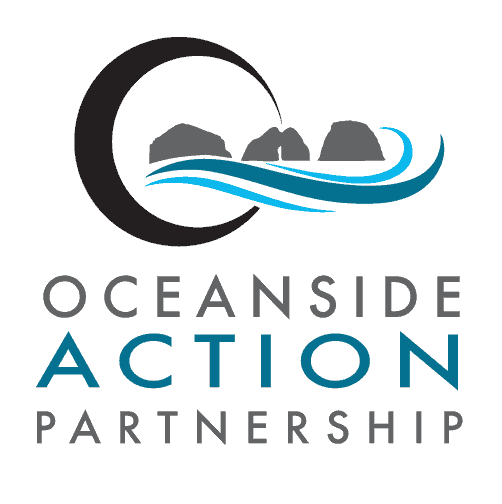In Phase II, the OAP is working toward becoming a 501(c)(3) charitable organization that will ““pursue funding and oversee project management” for the initiatives compiled in that Project Summary. These range from a “Welcome to Oceanside” street sign to a multi-million-dollar upgrade of Oceanside’s stormwater drainage system. To achieve them, the OAP plans to recruit and oversee “small project teams” of community volunteers tasked to conduct needed research, structure proposals and pursue grant funding. It has no governmental or other fixed revenue source, but will instead rely on donations, volunteers and grants that include administrative costs for individual projects.

The OAP held two more community workshops over the past month to recruit and organize volunteers for its project teams. At the “Small Team Kickoff” last Thursday (November 16), OAP President Bruce Jaeger was undeterred by what he termed a ‘smallish” turnout. Instead, he praised the commitment of the those who continued to attend as “doers” who were “ready for action.” The group then broke out into Teams on three subjects: (1) Infrastructure (primarily improved cell service); (2) Local Trails and (3) Signage (both informative signs and a “Welcome to Oceanside” sign). They are chaired by Yuriy Chanba, Gail Chun-Deduonni and Kris Woolpert, respectively. Jaeger closed the meeting by encouraging the teams to proceed independently, consulting the Board for advice or resources when needed. With a project list in hand, and enthusiastic project teams in the field, the OAP Board can now turn its attention and energy to operational readiness.
The idea of forming a private community development association concept surfaced early this year during a meeting where county officials advised OAP and ONA leaders that the Oceanside Neighborhood Association’s county charter would not allow it to manage development projects or seek major TLT gr ants. As the conversation turned to forming a 501(c)(3) association for such tasks, Chief of Staff Rachel Hagerty offered a warning. She cited the example of the now-defunct “Mid-County Parks and Recreation District” that was reliant on grants or donations and administered by an elected volunteer Board. That initiative started enthusiastically in 2018 but was ultimately dissolved within a few years because it went into debt to cover expenses and had trouble filling Board vacancies. To be clear, The Oceansider believes the OAP has assembled an impressive group of retired planning and finance professionals who are well-equipped to avoid the same fate. In working to do so, however, the following recent developments merit special attention:
ants. As the conversation turned to forming a 501(c)(3) association for such tasks, Chief of Staff Rachel Hagerty offered a warning. She cited the example of the now-defunct “Mid-County Parks and Recreation District” that was reliant on grants or donations and administered by an elected volunteer Board. That initiative started enthusiastically in 2018 but was ultimately dissolved within a few years because it went into debt to cover expenses and had trouble filling Board vacancies. To be clear, The Oceansider believes the OAP has assembled an impressive group of retired planning and finance professionals who are well-equipped to avoid the same fate. In working to do so, however, the following recent developments merit special attention:
1. Flagging Interest. OAP President Bruce Jaeger is a tireless proponent of the OAP effort. His uncompromising optimism, love for Oceanside and commitment to his vision infuse every meeting, email and page of the OAP website. That said, numbers don’t lie. Even OAP leaders acknowledge that their turnout has fallen sharply as it turns from gathering community input to recruiting actual Teams. In addition, the bulk of OAP’s leaders and active volunteers hail from or near a single neighborhood (Terrasea). The OAP will need broader engagement to achieve its goals.
2. Delayed Revenue. The IRS is taking much longer than the OAP expected to rule on its 501(c)(3) application. It currently projects a ruling by May 2024 although the OAP says Congresswoman Bonamici’s staff has alerted the IRS of her interest in its progress. Whether the delay reflects bureaucratic backlog or some issue with the application, it has blocked the OAP from soliciting tax-deductible donations or applying for grants for which 501(c)(3) status is required. Both are key elements of the revenue it needs to operate beyond the planning stage.

In the longer term, the OAP must now also prepare itself to arbitrate the selection of competing projects for grant submissions, negotiate and execute construction contracts, guarantee appropriate management of grant revenue from multiple sources with varying accountability requirements, manage and/or litigate quality disputes and cost-overruns, retain professionals for legal advice, accounting services and insurance, and comply with regulatory obligations of a 501(c)(3) charitable organization. These are functions that tax-funded local governments or much larger service organizations usually hire staff or consultants to perform. While the OAP has attracted Board several members and volunteers with extensive planning, finance and management backgrounds, this will still be a heavy lift for an organization with no paid staff or regular income.
Our neighbors on the OAP Board deserve our thanks for taking on such responsibilities to serve the community. That said, neither the Board nor the community will benefit if the OAP overextends itself or raises community expectations beyond what it can deliver. That would discredit Oceanside with external agencies, hamper fundraising by our other community groups and deter volunteers from joining future community initiatives. Now that it has completed its effort to introduce its mission to the community, this is an opportune time for the OAP to focus on its legal and operational readiness to carry it forward.
And that’s the view from Oceanside!
www.oceansidernews.com
jerrykeene@oceansidernews.com


